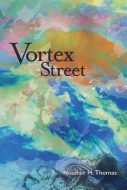 Heather H. Thomas
Heather H. Thomas
Vortex Street
FutureCycle Press
Reviewer: Ann Wehrman
Exploring Heather H. Thomas’s 2018 poetry collection Vortex Street, one stumbles into a dappled forest’s clearing where an ageless woman in a flowing, floral skirt and bright silk blouse, black hair glowing down her back, smiles and beckons one into her wagon. Every surface has been fantastically painted with sun/moon/stars, flowers and plants, animals and insects, all in vibrant colors that scoff at traditional harmonies, creating beauty beyond structure in riotous and rich overlay. She offers a cup of steaming herb tea; one sips, sits, and listens as she softly strums a guitar and sings, lyrics rendering images magical, personal, obscure, and evocative. She smiles and one nods, sinking into the dream she spins. Her tapestry is not a traditional epic tale; instead, she takes the reader dancing with her through the cosmos on spiderwebs of light.
On her website (www.heatherhthomas.com/my-story), Thomas writes, “My sixth book, Vortex Street, imagines the world as a series of vortices connected through air and water, starting with my own riverside street and extending to Newtown, Connecticut; Tanta, Egypt; Tel Aviv; Sarajevo; Istanbul and elsewhere. As a phenomenon of fluid dynamics, a vortex street disregards boundaries we think we have in place to protect us. In these poems, private and public urgencies travel through time and converge in a space that is borne, accepted, and reimagined.”
Original, creative, lyrical, wild, sparking, deft, compassionate, alive: the innovative Thomas uses language as an artist uses line and color, her strokes opening possibilities rather than carving precise definitions. She may be an enchanter; she may be part siren, part magical, part fey. Her poetry is her world, and one is privileged to enter it, to be challenged and maybe changed by the experience.
The collection consists of five sections, four with multiple poems of one or more pages, and one thematically cohesive inner section, “A Universe Strewn in Minute Threads,” including three short poems, each titled “Dear One,”—unique love notes to an unnamed recipient. The first “Dear One,” for example, communicates multiple layers of existence and awareness, more than the “normal,” daily world:
You say the shadow completes its own mark
of abandon. The world outside your door is not houses
or streets. Though you enter the clarity of morning,
your hair blows across your face.
That final line’s tactile imagery creates deeper feeling by peeking out from under the falling sheath of hair, like an afternoon’s shade brings coolness, opens one to tenderness or melancholy.
Section One, “Double Helix across the Sky,” includes the poem “Slit Silence,” which speaks of this brutal world, and by implication, of violence against women:
In Sarajevo, she timed her run across the bridge
—fifteen seconds between shots—
the leaves tender on trees not yet burned for fuel.
Snipers ringing the hills eyed her, eyed
anyone walking home from work or buying bread.
She counted the seconds on her watch before
running through slit silence, plate of the sun the only
unbroken thing until she reached the other side.
The protagonist is like prey as she sprints home through a space used for target practice. The poem speaks to the fear with which women too often live, the narrow corridors of emotional and psychic space they must negotiate to survive.
The poem, “Home,” also in Section One, reveals the essence of creative force in the sea/in a woman:
Where the tide carves a ledge, wave-thrust dissolves it,
erasing homes already abandoned.
Sea’s steel horizon holds as sand pitches and reels.
Sunset is a broken conch.
…
Shell-houses brittle and beautiful go home with me,
as if I could make myself small enough
To live in them. They will pile up in my face-jar transparent
with cold salt.
The smallest wave inside a person can light or extinguish
an ember. Nothing but that.
Reaching deep within, the poet notes the “ember” glowing and reminds readers that life force moves in waves, kindling new light, new life from darkness.
In Section Five, “The Time for Chrysanthemums,” the lyrical narrative “Murmuration” depicts an uncommon pair bonding and their short astral flight together:
Resonant reverb in my head
when the old woman behind me drops her cane
we’re standing in line at Staples
I pick up the cane and hand it back
there are angels walking among us in this world
I catch her gray-glazed eyes
…
together we fly up to the dome
she doesn’t need her cane
by aerodynamics in v-formation
geese save the energy needed to fly alone
red knots and dunlins fly faster
in the wingtip upwash for the bird ahead
we’re in each other’s murmur
her hand holding mine
The poet seems to allude to herself in “Phosphor”:
Saw-whet owl in the moon, a girl on stick legs
slipping down the fire escape
to a blank page
of yard, a sandbox bottle-cool. She flicks
night’s neon air, absolving old
romantic tenements.
Her nerves’ gold screen spreads its webs,
fastened to her as glints in sand
where she digs
Thomas’s poetry is grounded in risk, leaving safety behind, leaping out with a cry of truth. In “Risk,” the final poem in the collection, Thomas writes:
Why the less safe, the more true? My life tapped out on Mother’s mahogany table next to my wall of books…. The centuries collapse through each other like floors in a burning building until we get to this moment when water bursts through the wall of my bookshelves, scattering works of the authors who carried me through. What can this space hold but the hollow core as promise, light that protects as it pushes away?
In Vortex Street, Thomas creates murals on planes of air and sandcastles that waves reclaim, rendering beauty and adventure, a testament to that “ember” deep within, her proficiency with language, style, and artistry ever balanced, exceeded only by her fidelity to meaning, love, and jouissance.

